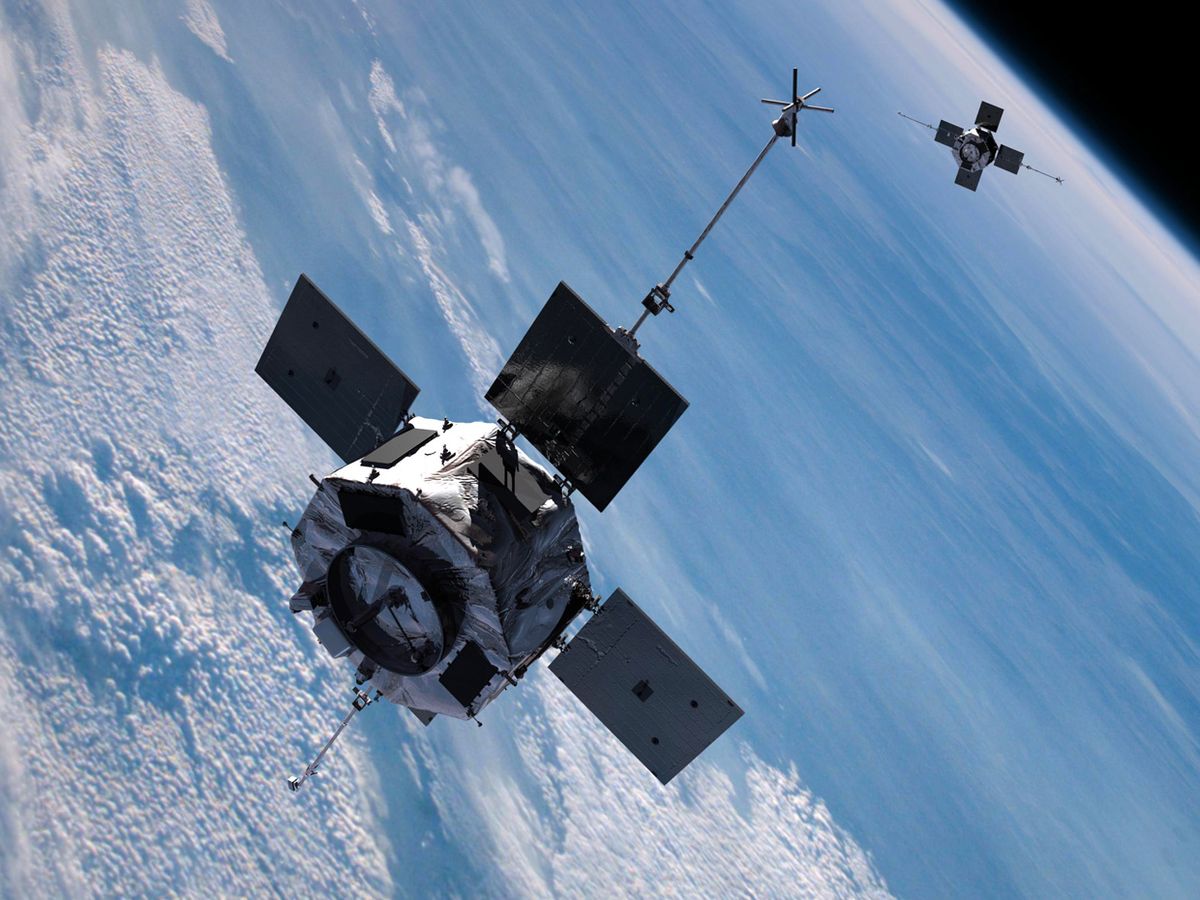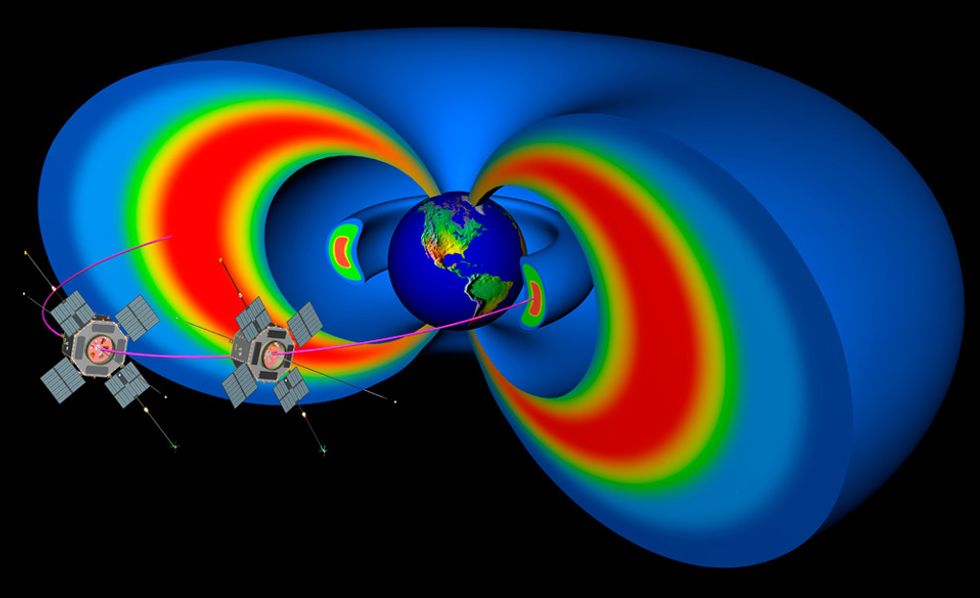UPDATE: 27 August 2012: 2:00 p.m. A problem communicating with a transponder mounted in the Atlas V rocket prevented a launch on Friday. Subsequent bad weather, including the arrival of Tropical Storm Isaac, has pushed the launch date back to no earlier than 30 August.
22 August 2012—In the wee hours of the morning of 24 August, NASA and the Johns Hopkins University Applied Physics Laboratory (APL) plan to launch a pair of research probes into the most hostile region of space around Earth: the Van Allen belts. The ultimate result should be longer–lasting satellites and safer tours of duty for astronauts.
The Radiation Belt Storm Probes (RBSP) mission will take off from Cape Canaveral atop an Atlas V rocket. The twin probes will then separate from the Atlas V and follow two slightly different, highly elliptical, orbits that will range from low earth orbit (a few hundred kilometers up) all the way out to where geostationary satellites operate (about 30 000 km up). For at least two years, the probes will continuously cycle through both the inner and outer Van Allen belts, where charged particles have been concentrated by Earth’s magnetic field.
In investigating the Van Allen belts, the RBSP mission is returning to the first major scientific discovery of the space age. Spurred on by Sputnik, the United States rushed to get a satellite aloft, finally succeeding with Explorer 1 in 1958. As it orbited, Explorer 1’s radiation detectors showed sharp changes in activity. Following confirmation of these results a couple of months later with Explorer 3, physicist James Van Allen realized that these changes were a result of the satellites passing in and out of one of the belts that now bear his name.
The Van Allen belts grow and shrink in response to changes in the space environment. This response is known as space weather, and it is largely driven by the solar wind, a stream of particles emanating from the outer layers of the sun. Shock waves in the solar wind created by solar activity can trigger geomagnetic storms. On the ground, these storms can disrupt communications and even cause blackouts, while in space their effect on the Van Allen belts can damage satellites and subject astronauts to unhealthy levels of radiation. But how the belts respond to space weather is so far unpredictable: One storm might result in the belts swelling up, but then “a few months later a similar event happens, and the radiation belts actually shrink. Other events happen, and you wouldn’t even notice there was a storm,” says Nicola Fox, deputy project scientist for the mission at APL.
The goal of the RBSP mission is to monitor the belts’ response to the solar wind better than ever before, in the hope that this will lead to an understanding of cause and effect in the processes that mold the belts. Improved predictions of how the belts behave will then guide engineers toward building spacecraft that can more easily ride out storms and give mission planners closer guidance about when orbiting astronauts are at risk. “The models that are currently used for a lot of design purposes are 30 and 40 years old,” says Louis Lanzerotti, a veteran space plasma physics researcher at the New Jersey Institute of Technology and the principal investigator for the RBSP Ion Composition Experiment, or RBSPICE, one of the five instruments being carried on both RBSP satellites.
The RBSP mission is the first to study the belts with a pair of satellites operating in tandem. Two satellites are better than one because they’ll allow scientists to get a firmer handle on the nature of the changes the satellites observe. Fox explains this with an analogy to a buoy floating on the surface of the ocean. If the buoy moves up and down, “you don’t know anything about what caused that buoy to go down and come up,” she says. But if you had a second buoy some distance away, “and they both went up and down at the same time, it might mean a really large-scale feature, like a tsunami. If one goes down and the other goes down a little bit later, you know you’ve got a wave and how fast it’s traveling, and if it’s getting stronger or weaker. If only one buoy moves, you know you’ve got a really localized feature,” says Fox.
Building the probes presented a challenge: When faced with a spike in radiation levels, typical satellites cope by shutting down as many systems as possible. This is because charged particles can upset electronics, reversing a bit in memory or causing a transistor to get stuck in an “on” state. But obviously this approach would defeat the purpose of the RBSP satellites.
Because the satellites must work in the harsh environment of the belts at their most active, the builders shielded each onboard electronics enclosure in nearly 9 millimeters of aluminum. In addition, the electronics themselves were designed to maximize the use of radiation-hardened components. However, some components were simply not available in radiation-hardened versions. In these cases, the RBSP builders turned to a technique known as ray tracing, looking at the likely angles of incidence of high-energy particles striking each electronics box, according to the box’s position and orientation inside the spacecraft. In some instances, for the most vulnerable parts, “you could move the location of components around on the printed wiring boards, maximizing the amount of shielding from the outer walls of the spacecraft and the box itself,” says the APL’s project manager for the mission, Rick Fitzgerald.
Once in orbit, the satellites will lap each other about once every 75 days. When they’re close together, they will provide fine-grained data about activity in specific locations in a belt; when farther apart, they will provide information about how the belt system behaves as a whole. The launch itself will be carried live online by NASA TV.
Stephen Cass is the special projects editor at IEEE Spectrum. He currently helms Spectrum's Hands On column, and is also responsible for interactive projects such as the Top Programming Languages app. He has a bachelor's degree in experimental physics from Trinity College Dublin.




